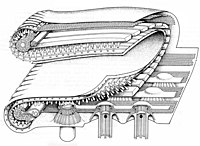Stephanopogon
 From Wikipedia the free encyclopedia
From Wikipedia the free encyclopedia
| Stephanopogon | |
|---|---|
 | |
| Stephanopogon sp. | |
| Scientific classification | |
| Domain: | |
| (unranked): | |
| Phylum: | |
| Class: | |
| Order: | Pseudociliatida |
| Family: | Stephanopogonidae |
| Genus: | Stephanopogon Entz 1884 |
| Type species | |
| Stephanopogon colpoda | |
| Species | |
| |
Stephanopogon is a genus of flagellated marine protist that superficially resembles a ciliate.
Characteristics
[edit]Stephanopogon closely resembles certain ciliates and was originally classified with them (,[1] but is now considered related to heterolobosean flagellates. The cell is somewhat flattened, with multiple smooth flagella arranged in rows running from the front to the back, and has an anterior mouth supported by rods. They feed on bacteria, diatoms, and other smaller organisms. There are 2-16 nuclei, but they are not differentiated into macronuclei and micronuclei as occurs in ciliates. They have a cosmopolitan distribution.

Classification
[edit]Because nuclear dimorphism is absent, Stephanopogon had been regarded as an evolutionary intermediate between the ciliates and other protozoa, and possibly an ancestor of the animals as well. Corliss and Lipscomb showed that it is not cytologically similar to ciliates, lacking their complex pellicle and infraciliature.[2] Further electron microscopical studies added details to the understanding of the cytological organization of Stephanopogon.[3][4] Yubuki and Leander demonstrated that Stephanopogon is closely related to Percolomonas within the Heterolobosea. The bases of the flagella in both genera are attached to an electron dense cytoskeletal material,[5] but it has been argued that this is not an apomorphy of the clade [6]
It has recently been included as a heterolosean in the class Percolatea, along with Percolomonas.[7]
The genus contains 7 species: S. apogon Borror, 1965, S. colpoda Entz, 1884, S. mesnili Lwoff, 1923, S. minuta Lei et al., 1999, S. mobilensis Jones et Owen, 1974, S. paramesnili Lei et al., 1999 and S. pattersoni Lee et al., 2014 [8]

References
[edit]- ^ Corliss, J. O. 1979. The Ciliated Protozoa: Characterization, Classification, and Guide to the Literature. Pergamon Press
- ^ Corliss, J.O. & Lipscomb, D.L. (1982). "Establishment of new order in kingdom Protista for Stephanopogon, long-known "ciliate" revealed now as a flagellate". Journal of Protozoology. 92: 294.
- ^ Patterson, D. J. & Brugerolle, G. 1988. The ultrastructural identity of Stephanopogon apogon and the relatedness of the genus to other kinds of protists. Europ. J. Protistol. 23: 279-290
- ^ Yubuki N, Leander BS (November 2008). "Ultrastructure and molecular phylogeny of Stephanopogon minuta: an enigmatic microeukaryote from marine interstitial environments". Eur. J. Protistol. 44 (4): 241–53. doi:10.1016/j.ejop.2007.12.001. PMID 18403188.
- ^ Fenchel, T. & Patterson, D. J. 1986. Percolomonas cosmopolitus (Ruinen) n. gen., a new type of filter feeding flagellate from marine plankton. J. mar. biol. Ass. U. K. 66: 465-482
- ^ Yubuki N, Leander BS 2008. Ultrastructure and molecular phylogeny of Stephanopogon minuta: an enigmatic microeukaryote from marine interstitial environments |journal=Eur. J. Protistol. 44: 241–53.
- ^ Cavalier-Smith T, Nikolaev S (2008). "The zooflagellates Stephanopogon and Percolomonas are a clade (class Percolatea: Phylum Percolozoa)". J. Eukaryot. Microbiol. 55 (6): 501–9. doi:10.1111/j.1550-7408.2008.00356.x. PMID 19120795.
- ^ Lee, W. J. 2019. Small free-living heterotrophic flagellates from marine intertidal sediments of the Sydney region, Australia. Acta Protozoologica: 58 167-189.